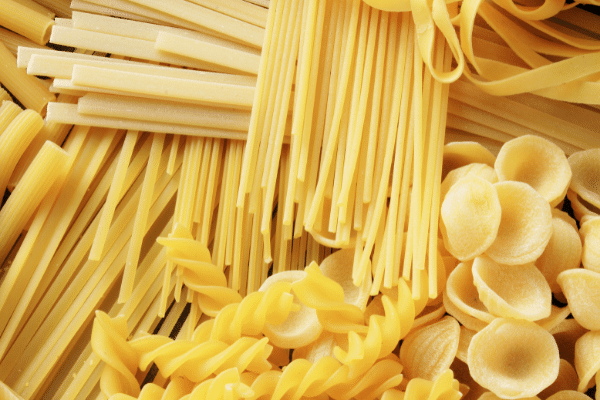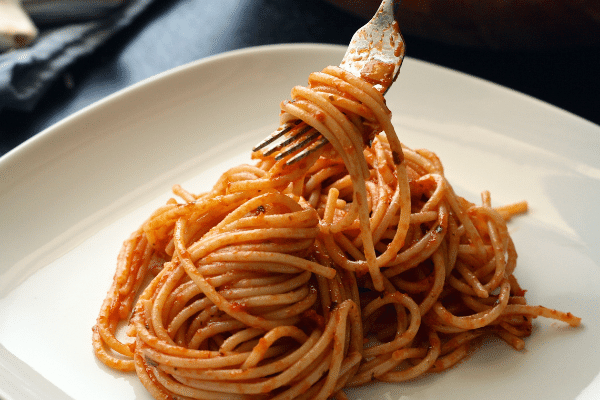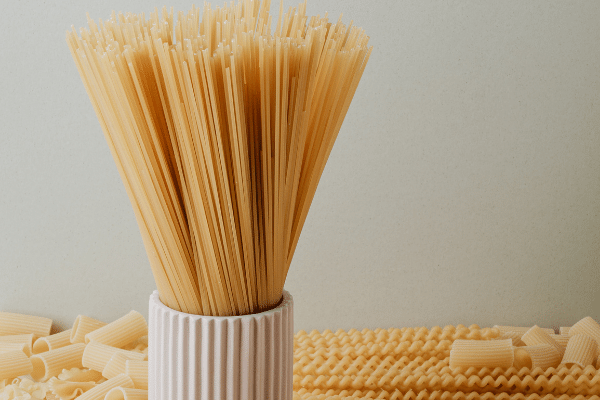
Since pasta is a kitchen staple, it is common to find old boxes and packets of pasta sitting at the back of the kitchen pantry. You might have a few boxes in your kitchen pantry too. Go ahead and check; we’ll wait.
If you do, you might want to use them ASAP as pasta is likely to go bad. It might show signs of spoilage, either before or after its expiration date. The former could happen due to incorrect storage techniques.
But you can avoid such situations by adhering to a few tricks and tips. Read along and find out how you can preserve your favorite pasta for a long period.
What is the Shelf-Life of Pasta?
Usually, the dry pasta comes with a use-by date printed on the label. The date is not the expiry date as it only tells how long it can keep its peak quality and freshness. Pasta is the kitchen staple that lasts longer, even past its use-by date.
It is difficult to estimate the exact shelf-life of dry pasta, but it can last for more than six months. It is applicable both for unopened and opened packages. However, the dry pasta may not taste fresh. You need to toss it for quality purposes.
For homemade pasta, it has a shorter shelf life. It only lasts for a couple of days. The store-bought pasta has the use-before date printed on the label, and it is a good estimate to use. Homemade pasta has a shelf-life of three to four days, provided that it is stored properly in a refrigerator.
The cooked leftovers of pasta can last up to four days when stored properly in a fridge. For a longer shelf-life, it is best to freeze the cooked pasta.
| Items | Pantry | Fridge |
| Dry Unopened and Opened Pasta | Use-By Day Plus One year | – |
| Fresh Store-Bought Pasta | – | Best-by Date Plus One to Two Days |
| Homemade Fresh Pasta | – | Three Days |
| Leftover Cooked Pasta | – | Three to Five Days |
Please note these are the rough estimates for best quality. Dry pasta has a long shelf-life and keeps its quality even after the use-by date.
What are the Spoilage Signs of Pasta?

The spoilage signs are the same for dried, fresh, cooked, and canned pasta. The first thing you need to do is to check the container of the pasta. If you see no damage or leakage in the container, check out for other spoilage signs.
Smell
The unpleasant and terrible smell of pasta means it has spoiled. So, when your pasta starts releasing a foul or unpleasant smell, discard it without using it further, as it means the pasta has gone bad and is no longer edible.
Color and Taste Change
The spoiled pasta will show off white spots and discolorations on the surface, indicating that the pasta has gone bad. So, if you see any color change in the pasta, discard it.
Dry pasta degrades with time, leading to taste change even when there is no change in appearance. The pasta will turn tasteless and stale after a prolonged period of storage. If you notice any taste change in pasta after cooking, discard it as it is no longer edible.
Texture Change
After a few days of storage, the pasta will turn gooey and slimy. It is the surefire sign of spoilage and occurs before mold formation on the pasta. So, if you see a texture change in the pasta, discard it immediately.
Pantry Worms and Bugs
You will seldom see any changes or spoilage signs in dry pasta because it won’t go rancid quickly. But, you may notice small holes in the packages because pantry bugs reproduce in the package. So, always check the old package before using it.
Mold Formation
If you see black, brown spots or white clouds on the cooked pasta dishes stored for more than four to five days means mold formation has started. You won’t see any changes in the dry pasta until it is exposed to high humidity.
What Happens When You Eat Spoiled Pasta?

Consuming uncooked pasta may cause Salmonella Poisoning because it comprises raw eggs as an ingredient. The symptoms of this illness include vomiting, upset stomach, and diarrhea. Cooked pasta is healthy, and it won’t cause any side effects because these bacteria are incapable of surviving in the drying process.
You must use old pasta cautiously because it gets contaminated easily and may make you ill. People have reported that the food-borne pathogen Bacillus Cereus forms in pasta in severe cases. Consuming it may cause cramps, nausea, diarrhea, and vomiting.
Poorly stored pasta must not be consumed as the ingredients, like raw eggs, dairy products, and more, are exposed to Campylobacter, Clostridium, and Listeria. So, you must store the food properly in a fridge at 40 Degrees Fahrenheit.
Can You Freeze Pasta? Refrigerated Vs. Shelf-Stable

Pasta keeps its peak quality in a freezer. Freezing is the best way to store the homemade cooked pasta as it helps prolong its shelf-life. But, it would help if you stored it in an airtight container or freezer bag that is sealed properly.
Freezing is not a good choice for dry pasta. But it doesn’t mean that you can’t freeze dry pasta. You may freeze it in a freezer but in an airtight container.
You must not store dry pasta in the original package inside a freezer because it traps excess moisture and may reduce quality and taste. Always use an airtight freezer-friendly container to store dry pasta in the freezer, and it can help the pasta last for six to eight months.
The cooked pasta can last for six to eight months in a freezer. However, the taste and quality may change with time.
Refrigerated
Pasta keeps its peak quality when appropriately stored in a fridge, but the dried pasta needs no refrigeration. Homemade pasta lasts longer when appropriately refrigerated. When properly refrigerated, fresh dry pasta lasts four days after the printed use-by date.
After opening, it must be transferred to an airtight container before refrigerating. However, cooked pasta meals last for one week in a refrigerator. However, the other ingredients in the cooked pasta may accelerate the spoilage process. But, if no ingredient is mixed, you must toss the pasta with olive oil before storing it to prevent the chances of clumping.
Shelf-Stable
Dry store-bought pasta keeps its quality when stored properly in dry and cool places in your pantry. Whether you have unopened or opened packages of dry pasta, you must transfer them to an airtight container before storing them in the pantry. It will prevent excess moisture and heat from leaking in.
The dry past can last one to two years past its use-by date when appropriately stored in the kitchen cabinet. However, homemade pasta won’t last long at room temperature outside a fridge. It is also applicable for cooked pasta as it quickly degrades when left outside a fridge.
What are the Best Methods to Store Pasta?
Many pasta brands share the storage requirements and instructions on the label, so you must check the instructions to store the pasta properly.
Store Dry Pasta in the Cupboard, Pantry, or Cabinet
The dry pasta keeps its peak quality when properly stored in your pantry, cabinet, or cupboard in cool and dry places. But, the container must be airtight and sealed to prevent the pantry bugs and moisture from leaking in.
Even the opened dry pasta package can be stored in an airtight and sealed container at room temperature. Fresh and homemade pasta needs refrigeration.
Use Airtight Container for Storage
Whether dry or fresh pasta, it starts degrading when stored inaptly. The best way to prolong the shelf-life of pasta is by storing them in an airtight container. The container must be properly sealed tightly before storing as it prevents pantry bugs and moisture from leaking in and spoiling the pasta.
The airtight container is also safe for homemade pasta as it prevents the pasta from drying. Since it contains no preservatives, an airtight container helps inhibit mold formation.
Store in Cool and Dry Places
Your kitchen pantry and cabinet’s cool and dry spots offer the best storage condition for dry pasta. So, you must find a dark, cool, and dry place in your pantry to store the pasta. The rule is applicable both for the unopened and opened packages of pasta.
Alternatives for Pasta if it has Gone Bad
If your pasta has a rancid smell or you have started noticing small worms, it is best to discard them and use the following substitutes instead:
- Regular Noodles
- Cabbage Noodles
- Spaghetti Squash
- Zucchini noodles
- Spiralized carrots
Frequently Asked Questions
What is the Shelf-Life of Dry Egg Pasta?
The dry egg pasta lasts as long as ordinary pasta, for one to two years past the printed use-by dates on the label. But, you must ensure that the egg pasta is stored sealed and tightly in an airtight container. If they start radiating unpleasant smells, discard them. The fat content in egg pasta radiates a foul smell when it starts degrading.
How Long Pasta Be Stored?
Fresh pasta can keep its peak quality for two to three days when properly refrigerated. If you don’t intend to use the pasta within two to three days, you must freeze it to preserve for another three months. The homemade pasta keeps well for one to two days when refrigerated, and in a freezer, it may last for two to three months.
How long is Cooked Pasta good in the Refrigerator?
Storing cooked pasta in an airtight container can help you retain its freshness and taste for 2 days. If your pasta has not been mixed with sauces, you can toss some olive oil to prevent clumping.
The Bottom Line
Hopefully, you know that dry pasta has a long shelf-life that can last for two to three years past its use-by date printed on the label. However, you must ensure storing the pasta is well-sealed in an airtight container to prevent excess moisture and pantry bugs from leaking.
Cooked and homemade pasta must not be left outside a fridge for more than two hours. Ensure to use an airtight container for pasta storage, which will help prolong the shelf-life.
The dried pasta may look edible and intact, but the taste and quality degrade after prolonged storage or two years.
Ensure to look for the spoilage signs before using old pasta stored in your pantry.



